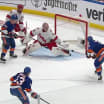"I might have thought so at the time," Stamkos said. "It's funny how you go through the summer and the training and strengthening and skating, and how much better it gets. It's almost night and day to where it felt physically and mentally towards the end of last season. When you're not putting pressure on yourself, you listen to your body. It's amazing how much better I've felt since then."
Upon his return, Stamkos saw some new faces in the Lightning locker room, including 19-year-old defenseman Mikhail Sergachev, who was acquired in a trade from the Montreal Canadiens for forward Jonathan Drouin on June 15, and veteran defenseman Dan Girardi, who signed a two-year contract with an average annual value of $3 million on July 1. The Lightning also signed veteran forward Chris Kunitz to a one-year contract the same day.
Though Stamkos liked the moves, he was surprised at the Drouin trade since he was considered a part of the Lightning's core.
"I mean it's tough, anytime you have a player of that skill set, it's tough to find," Stamkos said. "But you have faith in management and what they're doing. There's a lot of stuff that goes on when a trade of that magnitude is made that a lot of people don't know about. We were able to add a defenseman who is probably untradeable unless you throw a guy like Drouin out there."
The Lightning hope a healthy Stamkos will help them return to the Stanley Cup Playoffs after finishing one point behind the Toronto Maple Leafs for the second wild card from the Eastern Conference last season. Stamkos isn't ready to say he's 100 percent, but he will be a full participant in training camp with no restrictions.
"It takes time. Anytime you're out for as long as I was, it's going to take time to get adjusted back to game speed," Stamkos said. "I've skated a ton this summer and done a lot of drills on the ice and off the ice, but nothing can really replicate a game until you get in that situation. And once you do that, then you're going to know how your body feels.
"When you go through something like that, you just have to find ways to put yourself in a position to feel good and still find a way to be the player you know you can be. My expectations are that I'm going to get back to that player, hopefully right away. That's the plan and that's why you put in the work. We'll see how it goes."
Stamkos had an eventful offseason. He married his longtime girlfriend, Sandra Porzio, in Toronto on June 30 and continued his training program with former NHL veteran Gary Roberts by adding some forms of tumbling gymnastics and grappling movements to work on his balance and coordination, and putting his body in situations where it must react.
"We implemented some new stuff," Stamkos said. "Every summer you have to try to tweak something, but when you're injured, there are certain movements that feel good and certain movements that don't. You want to find ways to make them feel good all the time. It was good and in that regard, it kept it fun and exciting to come to the gym knowing that we're going to do some different things to make [the knee] feel better."


















